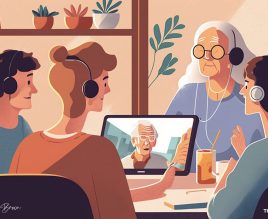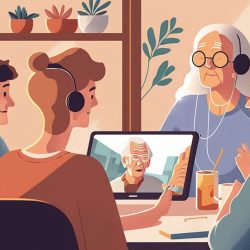Table of Contents
ToggleThe world is rapidly aging, with the number of people aged 60 years or older expected to double by 2050. As the global population ages, technological advancements have become increasingly important in addressing the unique challenges and needs faced by the elderly. Discover the transformative impact of technology in enhancing the quality of life for seniors. Explore the crucial role of technology for the elderly, which spans communication, social connections, health, safety, and maintaining independence.
As the demand for elderly care services grows, the healthcare system faces immense pressure to cater to the needs of an aging population. Technological solutions can help alleviate this burden by providing innovative, cost-effective ways to support seniors. These solutions can enhance the quality of life for the elderly, their caregivers, and their families while improving the overall efficiency of elderly care services.
Enhancing Communication and Social Connections

In an increasingly connected world, technology plays a crucial role in enhancing communication and fostering social connections, particularly for seniors. As the elderly population faces unique challenges, such as mobility limitations and social isolation, embracing various technological tools can help them stay engaged and maintain strong connections with friends, family, and their communities. Let’s explore some of the ways technology can support seniors in this regard.
Video Calling and Messaging Apps
Video calling and messaging apps, such as Skype, FaceTime, and WhatsApp, have become essential tools for seniors to stay connected with their loved ones. These apps enable real-time communication, allowing the elderly to maintain social connections and reduce feelings of isolation and loneliness. As these technologies continue to evolve, features such as automated captioning and translation may further improve the user experience, making communication even more accessible to seniors with hearing or language barriers.
Social Media Platforms
Social media platforms, including Facebook, Twitter, and Instagram, offer seniors the opportunity to stay informed about the lives of their family members and friends. Sharing photos, updates, and messages, the elderly can remain active in their social circles and maintain a sense of belonging. These platforms also offer the potential for seniors to engage in intergenerational dialogue and learning, bridging the gap between different age groups and fostering a deeper understanding of one another’s perspectives.
Virtual Communities for the Elderly
Online forums and support groups cater to seniors’ specific interests and concerns, allowing them to connect with like-minded individuals. These virtual communities allow the elderly to share experiences, advice, and emotional support, fostering a sense of camaraderie and understanding. As these communities grow and diversify, seniors may have access to a broader range of resources and connections, further enriching their social lives and promoting mental well-being.
Hobbies and Interest-Based Communities
Hobbies and interest-based communities cater to seniors who wish to explore new interests or continue pursuing existing passions. Websites and apps dedicated to gardening, cooking, travel, or other hobbies allow seniors to engage in meaningful activities, learn new skills, and connect with others who share their interests. By providing a space for seniors to express their creativity and curiosity, these communities can contribute to a sense of purpose and satisfaction, ultimately enhancing overall quality of life.
Supporting Mental Health and Cognitive Function

Brain training apps like Lumosity and Elevate offer cognitive stimulation exercises designed to improve memory, focus, and other cognitive skills. These apps can help seniors maintain mental sharpness, potentially delaying the onset of cognitive decline. In addition to traditional brain training exercises, emerging technologies such as augmented reality (AR) and virtual reality (VR) may provide novel ways to engage seniors cognitively, offering immersive and interactive experiences that stimulate various cognitive domains. As these technologies continue to evolve, they can offer even more targeted and engaging cognitive interventions that cater specifically to seniors’ needs and preferences.
Virtual Reality Therapy for Dementia and Alzheimer’s
Virtual reality (VR) therapy has emerged as a promising tool in treating dementia and Alzheimer’s disease. By immersing patients in familiar or therapeutic environments, VR therapy can help reduce agitation, anxiety, and depression while improving cognitive function and memory recall. As research in this area progresses, VR therapy may become increasingly personalized and effective, offering a valuable complement to traditional dementia and Alzheimer’s treatments. The development of more advanced VR experiences could enable a deeper understanding of patients’ cognitive processes and contribute to more effective, customized therapeutic interventions.
Online Counseling and Mental Health Resources
Online counseling and mental health resources, such as teletherapy platforms and self-help tools, provide seniors with accessible and convenient options for addressing mental health concerns. These resources can help reduce the stigma surrounding mental health issues and ensure seniors receive the support they need. As teletherapy and other digital mental health tools become more prevalent, they may offer additional features tailored to seniors’ unique needs, such as cognitive behavioral therapy (CBT) modules for age-related anxiety or depression. The integration of artificial intelligence (AI) and machine learning in mental health platforms could further enhance personalization, making it easier for seniors to access and benefit from these resources.
Assisting with Daily Living and Independence

As seniors age, they may face challenges in maintaining their independence and completing daily tasks. Leveraging technology can provide valuable assistance, empowering seniors to continue living fulfilling lives while maintaining their autonomy. In this detailed discussion, we will explore various technologies designed to support seniors in their daily lives and promote independence.
Voice-Activated Assistants
Voice-activated assistants like Amazon’s Alexa and Google Home can help seniors easily manage daily tasks. These devices can provide reminders for medication, control lights and appliances, and offer instant access to information, allowing seniors to maintain their independence and age gracefully. As these AI-powered assistants become more advanced, they may also offer personalized recommendations, such as suggesting activities, providing news updates, and even engaging in conversation to help reduce social isolation.
Remote Monitoring and Control
Smart home systems, with sensors and cameras, enable remote monitoring and control of a senior’s living environment. Caregivers and family members can use these systems to ensure the safety and well-being of their loved ones, while seniors can maintain their privacy and autonomy. The integration of AI into smart home systems may lead to more proactive monitoring, predicting potential hazards and providing alerts to both seniors and caregivers, further enhancing safety and peace of mind.
Personal Emergency Response Systems
Personal emergency response systems (PERS) provide seniors with direct communication with emergency services and caregivers during a fall or other crisis. By wearing a pendant or wristband with a built-in help button, seniors can quickly summon assistance, ensuring their safety and peace of mind. Future developments in PERS may include advanced sensing technologies, such as heart rate monitoring and fall detection, providing even more comprehensive support for seniors in emergencies.
Assistive Devices and Mobility Aids
Mobility and independence are critical aspects of a senior’s quality of life. Assistive devices and mobility aids can help seniors overcome physical limitations and continue engaging in their daily activities. In the following sections, we will examine various technologies designed to support and enhance seniors’ mobility and independence.
Robotic Exoskeletons
Robotic exoskeletons can assist seniors with mobility challenges, enabling them to walk, stand, and perform daily activities more easily. These devices can improve seniors’ quality of life and help them maintain independence. As exoskeleton technology advances, devices may become more affordable, lightweight, and user-friendly, making them accessible to a larger population of seniors in need of mobility assistance.
GPS-Enabled Walking Aids
GPS-enabled walking aids, such as smart canes and walkers, can provide seniors with guidance and support while navigating their environment. These aids can help seniors maintain mobility and confidence, empowering them to continue engaging in their communities. Future developments in GPS-enabled walking aids may include obstacle detection and avoidance features, further enhancing the safety and utility of these devices for seniors.
Promoting Physical Health and Well-being
Maintaining physical health is essential for seniors to enjoy a fulfilling and active life. Technological advancements can play a vital role in supporting seniors’ well-being by providing tools to monitor and improve their health. We will discuss different technologies and strategies that promote physical health and well-being in older adults.
Telemedicine and Remote Healthcare Services
Telemedicine allows seniors to access healthcare services remotely, reducing the need for in-person appointments and providing timely medical attention. It can enhance the quality and efficiency of healthcare for seniors through video consultations, remote monitoring, and digital health records. As telemedicine continues to evolve, it may offer even more specialized services tailored to seniors’ needs, such as remote physical therapy or rehabilitation programs.
Wearable Health Monitoring Devices
Wearable health monitoring devices, such as smartwatches and fitness trackers, can help seniors track their physical activity, heart rate, sleep patterns, and more. These devices can empower seniors to take charge of their health and make informed decisions about their well-being. As wearable devices advance, they may offer even more accurate and comprehensive health monitoring, including detecting early signs of potential health issues and providing personalized recommendations for improving health outcomes.
Fitness and Wellness Apps Tailored for Seniors
Fitness and wellness apps for seniors offer tailored exercise programs, nutrition advice, and wellness tips. By addressing seniors’ unique needs and limitations, these apps can help promote a healthy and active lifestyle, improving overall well-being. As these apps become more sophisticated, they may also integrate with wearable devices and healthcare platforms, providing a more holistic approach to senior health
Ensuring Safety and Security
The safety and security of seniors are paramount concerns, both at home and in their interactions with technology. In this section, we will delve into various technologies and resources that can help protect seniors from potential threats and hazards, enabling them to feel secure and confident.
Fall Detection and Prevention Technology
Fall detection and prevention technology, such as wearable devices and smart flooring, can alert caregivers and emergency services when a senior experiences a fall. This technology can also help identify potential fall hazards and suggest interventions to reduce the risk of falls, enhancing seniors’ safety and confidence. As these technologies continue to advance, they may provide even more comprehensive fall detection and prevention features, such as real-time monitoring of gait and balance to identify potential falls before they occur.
Home Security Systems and Smart Locks
Home security systems and smart locks can provide seniors with protection and peace of mind. These systems can monitor for intruders, fire, and other hazards, ensuring seniors feel secure in their homes. As home security technology evolves, it may offer additional features tailored to seniors’ needs, such as integration with medical alert systems or voice-activated controls for ease of use.
Online Safety and Scam Protection Resources
Online safety and scam protection resources can help educate seniors about the potential risks of using technology, such as identity theft and phishing. These resources can protect seniors from cyber threats by raising awareness and promoting safe online practices. With the ongoing development of new cyber threats, these resources will need to be continually updated and expanded to ensure seniors stay informed and protected.
Encouraging Lifelong Learning and Skill Development
Lifelong learning and skill development are essential for seniors to stay engaged, intellectually stimulated, and adaptable in a rapidly changing world. In the following discussion, we will explore the role of technology in supporting seniors’ ongoing education, personal growth, and skill development.
Online Educational Platforms and Courses
Online educational platforms and courses allow seniors to continue learning and developing new skills. These resources can help seniors stay engaged and intellectually stimulated, covering a wide range of subjects from language lessons to art classes. As online education continues to grow, more courses specifically designed for seniors may become available, catering to their unique interests and learning styles.
Access to Digital Libraries and Resources
Digital libraries and resources provide seniors with access to a wealth of information, from e-books and audiobooks to research databases and historical archives. These resources can support seniors’ pursuit of knowledge and lifelong learning. As digital libraries and resources expand, they may become even more user-friendly and accessible, further supporting seniors’ educational endeavors.
Hobbies and Creative Pursuits through Technology
Technology can also engage seniors in hobbies and creative pursuits, such as digital photography, painting, or music composition. Technology can help seniors explore their creativity and enrich their lives by providing new tools and mediums for expression. As technology continues to advance, it may offer even more opportunities for seniors to engage in creative pursuits, from virtual art galleries to collaborative online projects.
Financial Management and Planning

Effective financial management and planning are crucial for seniors to maintain stability and independence during their retirement years. In this section, we will discuss the various technologies and resources that can help seniors manage their finances, plan for the future, and protect their financial well-being.
Online Banking and Financial Tools
Online banking and financial tools can help seniors manage their finances more efficiently, allowing them to track their expenses, pay bills, and monitor their accounts from the comfort of their homes. These tools can also give seniors valuable financial insights and advice, promoting financial stability and independence. As fintech continues to develop, more sophisticated financial tools and services tailored to seniors may become available, further supporting their financial well-being.
Retirement Planning and Investment Platforms
Retirement planning and investment platforms give seniors the resources and guidance to make informed decisions about their financial future. These platforms can help seniors achieve their financial goals and maintain their desired lifestyle during retirement by offering personalized advice and access to various investment options. As these platforms continue to evolve, they may provide even more tailored and comprehensive retirement planning solutions for seniors.
Fraud Detection and Protection Services
Fraud detection and protection services can safeguard seniors’ finances by monitoring for suspicious activity and providing alerts when potential fraud is detected. By staying vigilant and utilizing these services, seniors can protect their financial well-being and enjoy greater peace of mind. As cyber threats become more sophisticated, fraud detection and protection services will need to adapt to ensure seniors’ finances remain secure.
Addressing Ageism and Technological Barriers
Ageism and technological barriers can hinder seniors’ ability to fully benefit from the advancements in technology. In this part of the discussion, we will explore strategies and initiatives aimed at overcoming these challenges and ensuring that technology is accessible and inclusive for seniors.
The Importance of Digital Literacy for Seniors
Digital literacy is crucial for seniors to navigate and benefit from technology effectively. By improving their digital skills, seniors can access information, resources, and services to enhance their quality of life and promote independence. As technology continues to advance, the importance of digital literacy for seniors will only grow, making it essential for them to keep up with evolving technologies and applications.
Tailored Technology Education and Training Programs
Tailored technology education and training programs can help seniors overcome technological barriers and learn to use devices and applications confidently. These programs can empower seniors to embrace technology and its benefits by offering personalized, age-appropriate instruction. As the range of available technologies expands, technology education and training programs will need to adapt and offer instruction on new devices and applications that are relevant to seniors’ needs and interests.
The Role of Inclusive Design in Technology Development
Inclusive design is essential to ensure that technology is accessible and user-friendly for seniors. By considering the unique needs and limitations of the elderly during the development process, technology companies can create more accommodating and beneficial products for seniors. As technology continues to advance, it is crucial that inclusive design remains a priority so that seniors can fully participate in and benefit from the digital world.
Conclusion
Technology possesses the remarkable potential to significantly transform the lives of seniors, addressing a wide array of needs and challenges they face. By enhancing communication and social connections, promoting physical health and well-being, and supporting mental health and cognitive functions, technology empowers seniors to lead fulfilling, independent lives with dignity and confidence.
As the global population continues to age, the demand for innovative, accessible, and user-friendly technological solutions will inevitably increase. By investing in research and development, fostering digital literacy among seniors, and prioritizing inclusive design, society can harness the transformative power of technology to improve the lives of the elderly and support an aging population.
Moreover, it is essential to address the challenges seniors may encounter when using technology, such as privacy concerns, online scams, and feelings of isolation. By raising awareness about these risks and promoting safe online practices, seniors can mitigate potential threats and fully enjoy the benefits of technology.
In conclusion, technology holds the key to enabling seniors to live more fulfilling, connected, and independent lives. By embracing technological advancements, providing tailored education and training programs, and ensuring the accessibility and inclusivity of new developments, society can work together to create a brighter, more supportive future for the aging population.
Want to learn more about elderly learning? Click here.
Frequently Asked Questions (FAQs)
What are the potential risks of using technology for the elderly?
The potential risks of using technology for the elderly involve privacy concerns arising from data sharing, susceptibility to online scams, fraud, and phishing attacks, as well as increased feelings of isolation resulting from excessive reliance on technology for social interaction. However, by promoting digital literacy, safe online practices, and striking a balance between technology use and in-person connections, seniors can mitigate these risks and reap the rewards of technology.
What are some examples of technologies specifically designed for seniors?
Examples of technologies designed for seniors encompass voice-activated assistants like Amazon Alexa, smart home systems for enhanced security and convenience, wearable health monitoring devices such as smartwatches, and various assistive devices including robotic exoskeletons and GPS-enabled walking aids to improve mobility and independence.
How can seniors learn to use new technologies effectively?
To effectively learn and adapt to new technologies, seniors can enroll in tailored technology education and training programs, seek guidance and support from knowledgeable friends or family members, and explore a plethora of online resources, tutorials, and step-by-step guides that cater to their specific learning needs.
How can we make technology more accessible for seniors with limited resources?
To make technology more accessible for seniors with limited resources, organizations and communities can offer free or low-cost technology education and training programs, provide access to public computers and internet services, and promote affordable technology options designed for seniors. Additionally, technology companies can prioritize inclusive design and develop cost-effective solutions for the elderly.
References
- https://www.acpdecisions.org/
- https://www.healthcaredive.com/
- https://www.serenity-senior-care.com/


















2 Comments
[…] Also read: The Crucial Role of Technology for the Elderly – Empowering the Golden Years […]
[…] a world increasingly driven by technology, AI has found a prominent place in promoting wellness. From personalized fitness plans to […]